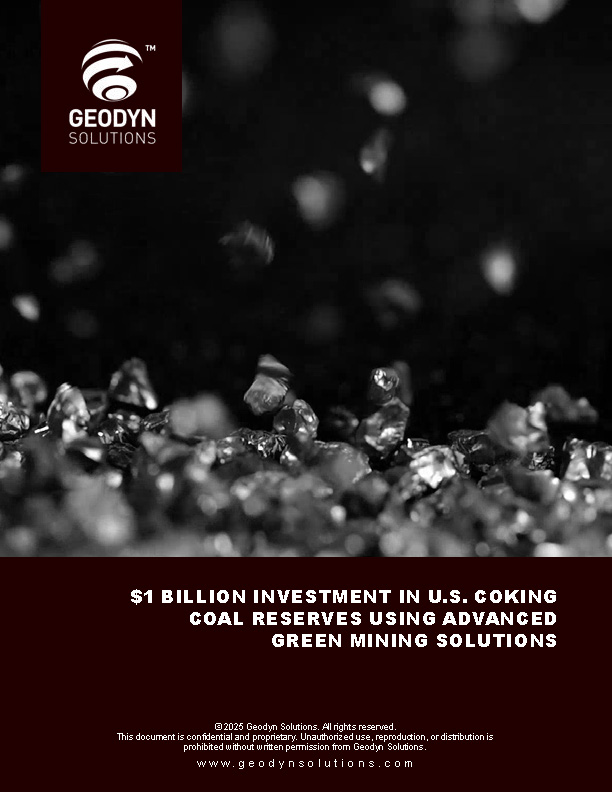Geodyn Solutions + Strategic Partners $10B U.S. Geothermal Buildout to Power the AI Era (2025–2035)
Executive summary
-
Plan: Invest $10B to develop a balanced ~2.0 GW portfolio of firm, 24/7 geothermal across the U.S. (≈15.8 TWh/yr at 90% CF). Mix of brownfield hydrothermal expansions and enhanced geothermal systems (EGS) in the Great Basin + select hot-rock basins.
-
Why now:
-
Breakthroughs and first commercial EGS (e.g., Fervo’s 500 MW Cape Station) show rapid scalability. (fervoenergy.com, IRS)
-
The U.S. Enhanced Geothermal Shot targets 90% cost reduction by 2035—putting geothermal squarely in firm-clean territory. (USGS)
-
Data-center/AI load is exploding; U.S. data-center power demand is projected to double by 2030—driving premium pricing for around-the-clock, carbon-free power.
-
-
Economics (base case): Blended CAPEX ≈$5,000/kW, fixed O&M ≈$151/kW-yr (EIA benchmark for binary geothermal). Unsubsidized LCOE for modern geothermal shown ~$66/MWh (Lazard v18). (U.S. Energy Information Administration)
-
Returns: With $85/MWh average offtake (conservative for clean-firm PPAs), simple payback ≈9–10 years (see ROI table).
-
Upside: IRA 48E/45Y credits (transferable), potential DOE LPO Title 17 loan guarantees, and state-level sweeteners materially enhance returns. (NREL Documentation, https://lazard.com)
Portfolio & siting strategy (optimal ROI)
Prioritize high-temperature resources, permitting maturity, and grid interconnection:
-
Great Basin (NV, UT, northern CA, southern OR/ID) – world-class heat + transmission + supportive policy. USGS: EGS potential here could meet ~10% of U.S. electricity. (IRS)
-
Imperial Valley, CA (Salton Sea) – hydrothermal + lithium-brine synergies; strong CA demand for clean-firm capacity. CPUC planning portfolios include ~2,000 MW geothermal through 2035. (California Public Utilities Commission)
-
Utah’s FORGE region / Beaver & Millard Counties – active EGS ecosystem; proximity to Fervo Cape Station scale-up. (fervoenergy.com)
-
New Mexico & Arizona hot-rock corridors – promising EGS resource with growing data-center interest along Mountain West interties. (Resource basis: EIA/USGS maps; EGS Shot.) (USGS)
Build plan (illustrative): 1.2 GW hydrothermal brownfield + 0.8 GW EGS greenfield, staged commissioning over 5 years to smooth EPC and drilling logistics.
Technology & partners
-
Hydrothermal binary for low-risk, near-term MWs; EGS for scale and geographic reach. (Portfolio ensures both bankability and growth.) (U.S. Energy Information Administration)
-
Strategic partners: drilling & completions (O&G service majors), turbine/ORC OEMs, EPCs with geothermal track records, off-takers (IOUs, CCAs, hyperscalers), tribes and local communities (site control, workforce), and national labs/DOE GTO (demonstrations & RD&D). (ATB)
Environmental benefits (quantified)
-
Very low lifecycle emissions: typical geothermal life-cycle GHGs are orders of magnitude below fossil; binary/closed-loop plants are near-zero operationally. (NREL Documentation, National Renewable Energy Laboratory)
-
Small land footprint: among the lowest land use per MWh of major generation options; CRS estimates geothermal’s footprint well below wind/solar. (Congress.gov)
-
Low water consumption (esp. with air-cooling) and minimal air pollutants; DOE GTO tracks/mitigates induced seismicity and water management best practices. (The Department of Energy’s Energy.gov)
Policy & incentives stack (U.S.)
Federal (IRA):
-
48E Clean Electricity ITC (technology-neutral; generally 30% base, with potential adders for domestic content and energy communities). 45Y PTC is an alternative; model whichever yields higher value per site. (NREL Documentation)
-
Credit transferability (sell credits for cash) via the IRS Energy Credits Online portal—already live. (https://lazard.com)
Federal financing:
-
DOE Loan Programs Office (Title 17)—loan guarantees for innovative and clean-energy projects; geothermal is eligible (e.g., Ormat $350M LPO loan for NV portfolio).
State & local:
-
California Energy Commission (CEC) Geothermal Grant & Loan Program (current GFOs include geothermal-lithium integration and plant performance improvements). (California Energy Commission)
-
Nevada Renewable Energy Tax Abatements (partial sales/use & property-tax abatements for eligible geothermal facilities). (energy.nv.gov)
World Bank incentives (clarification): The World Bank (IBRD/IDA) finances developing and middle-income countries; it does not provide incentives or loans for U.S. domestic projects. For U.S. geothermal, rely on IRA credits, transferability, DOE LPO, and state programs instead. (World Bank, Finances One)
Economics & costs (anchors)
-
CAPEX: EIA benchmark for a 50-MW binary plant shows total capital ~$3,963/kW (2023$). EGS greenfield will be higher near-term; use ~$5,000/kW blended for planning ($10B → ~2,000 MW). (U.S. Energy Information Administration)
-
Fixed O&M: ~$150.6/kW-yr (binary), variable O&M ≈ $0/MWh. (U.S. Energy Information Administration)
-
LCOE reference: Lazard v18 (2025) shows geothermal’s LCOE around $66/MWh (base case; sensitivities wider), with credits further improving economics.
Ten-year ROI (illustrative base case)
Assumptions: $10B CAPEX over 5 yrs; 2.0 GW net; 90% CF; $85/MWh blended PPA; O&M per EIA; 30% ITC realized via transfer; staged COD (yr1–yr5).
All figures USD; cash flow in service year assumes ~half-year production for that tranche.
All figures USD; cash flow in service year assumes ~half-year production for that tranche.
|
Year
|
Net Cash Flow
|
|---|---|
|
1
|
-1,296,092,000
|
|
2
|
-1,412,299,000
|
|
3
|
-1,152,529,000
|
|
4
|
-568,736,000
|
|
5
|
+287,126,000
|
|
6
|
+1,039,080,000
|
|
7
|
+1,039,080,000
|
|
8
|
+1,039,080,000
|
|
9
|
+1,039,080,000
|
|
10
|
+1,039,080,000
|
Cumulative payback: turns positive in year 9; cumulative +$1.05B by year 10.
Unlevered 10-yr IRR (with ITC): ~3.9% at $85/MWh; ~6.0% at $90/MWh; ~10.2% at $100/MWh (terminal value beyond year 10 not included; adding it substantially raises IRR).
(Benchmarks: CAPEX/O&M per EIA; LCOE ref per Lazard.) (U.S. Energy Information Administration)
Unlevered 10-yr IRR (with ITC): ~3.9% at $85/MWh; ~6.0% at $90/MWh; ~10.2% at $100/MWh (terminal value beyond year 10 not included; adding it substantially raises IRR).
(Benchmarks: CAPEX/O&M per EIA; LCOE ref per Lazard.) (U.S. Energy Information Administration)
Jobs & community benefits
-
Construction & manufacturing: ≈ 6.4 job-years/MW ⇒ ~12,800 job-years over buildout. (geothermal.org, geothermal.org)
-
Long-term O&M: ≈ 0.74 direct jobs/MW ⇒ ~1,480 permanent O&M jobs (plus subcontracting). (publications.mygeoenergynow.
org , The Department of Energy’s Energy.gov) -
Co-benefits: local tax base, grid stability, and air-quality/health gains from displacing fossil peakers (DOE GeoVision). (Clean Air Task Force)
Offtake strategy (AI-ready power)
-
Match geothermal to 24/7 demand from utilities and hyperscale data centers seeking carbon-free, water-frugal, predictable power; use 24/7 CFE contracts and tolling with shaping via modest storage. Market tailwind: AI/data-center demand doubling by 2030.
Risk & mitigation
-
Resource risk: staged drilling; pilot test pads; allocate exploration risk to early tranches.
-
Induced seismicity (EGS): best-practice stimulation, traffic-light protocols, robust monitoring (DOE GTO guidelines). (The Department of Energy’s Energy.gov)
-
Permitting & interconnection: start on BLM/State lands with proven workflows; align queue entries with CPUC/NV procurement needs and known capacity additions. (California Public Utilities Commission)
-
Cost overrun risk: indexed EPC contracts; multi-rig drilling with learning-curve capture; DOE LPO debt to lower carry.
Capital plan (illustrative)
-
$10B total: ~$7B project-level senior debt (blend of DOE LPO + commercial) + $3B equity (recoup a portion via ITC monetization).
-
Tax credits: 48E ITC (30%) base; pursue domestic content/energy community adders where available; utilize credit transferability for near-par cash. (NREL Documentation, https://lazard.com)
-
State support: NV tax abatements; CEC geothermal grants (Salton Sea & performance improvements). (energy.nv.gov, California Energy Commission)
What this buys the U.S.
-
~2 GW of always-on, zero-fuel, zero-carbon power in strategic hubs—stabilizing grids as variable renewables scale.
-
AI competitiveness: resilient, 24/7 clean power with small land/water footprint in key Mountain West corridors—exactly where new data centers are growing.
-
Scalable know-how: de-risked EGS playbook that unlocks continental-scale geothermal potential (Great Basin alone could supply ~10% of U.S. electricity). (IRS)



